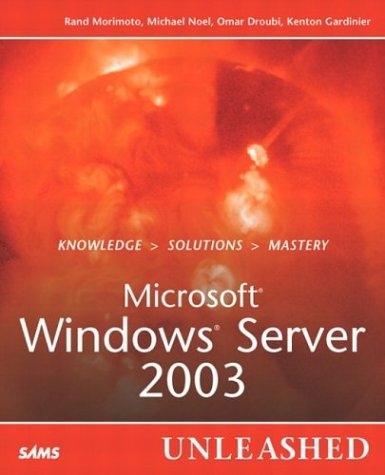
Microsoft Windows Server 2003 Unleashed
Sams Publishing (Verlag)
978-0-672-32154-2 (ISBN)
- Titel erscheint in neuer Auflage
- Artikel merken
A fresh perspective on planning, designing, implementing, and migrating to a Windows Server 2003 environment. Rand Morimoto and his co-authors began writing this book using their experience from several very large client implementations, some having more than 100 servers in production. On a daily basis, as this book was in production, they had clients with thousands of users taking advantage of the Windows Server 2003 security, scalability, performance, and reliability functions months before the product release. Because of that unique experience, the authors of this book were able to compile the best practices, installation and migration tips and tricks, performance optimization techniques, configuration tuning, and server management techniques for the readers of this book. Rather than revising from previously published chapters in the Windows Server 2000 Unleashed book, this book was written completely from scratch with the belief that this approach would incorporate the true recommendations from the author team for best practices, tips and tricks to get the most out of Windows Server 2003 networking environment.
Rand Morimoto has been in the computer industry for over 25-years and has authored, co-authored, or been a contributing writer for over a dozen books on Windows 2000, Security, Exchange 2000, BizTalk Server, and Remote and Mobile Computing. Rand is the President of Convergent Computing, an IT-consulting firm in the San Francisco Bay Area that was one of the key early adopter program partners with Microsoft implementing beta versions of Windows Server 2003 in production environments over 2-years before the product release. Besides speaking at over 50 conferences and conventions around the world in the past year on tips, tricks, and best practices on planning, migrating, and implementing Windows Server 2003, Rand is also a Special Advisor to the Whitehouse on Cyber-Security and Cyber-Terrorism. Michael Noel has been in the computer industry for over 9 years and has been working with the latest in Windows technologies since the early days of Microsoft operating systems. Michael has written numerous technical publications and has been a contributing writer on books on Windows 2000, Exchange 2000, and Microsoft Operations Manager. Currently a Consultant at Convergent Computing in the San Francisco Bay Area, Michael has designed and implemented numerous large-scale technical projects with worldwide Active Directory and Exchange 2000 migrations, high-availability clustering solutions, and enterprise anti-virus solution deployments. Michael's experience in the area of real-world design and deployment and his level of involvement in Windows server technologies (including Windows Server 2003) from the beta stages supports his credentials in the field. Omar Droubi has been in the computer and networking industry for more than 9 years and has worked as a consultant assisting small, medium and large organizations introduce and manage Microsoft Technologies ranging from directory services, messaging systems, databases, Virtual Private Networks and Firewalls. Omar's specialties include designing scalable Windows based networks that are focused on meeting clients' computing and networking requirements. Omar is an expert at integrating Windows systems or migrating to Windows 2003 Active Directory from Novell NetWare, Unix, and Banyan Vines. Omar is not only a skilled designer and implementer of the Windows Server 2003 family of products, but he is also a qualified and certified Microsoft trainer (MCT). Omar is an MSCE and has been a contributing writer on a Microsoft Exchange 2000 book and on occasion has written material for Microsoft focused on Windows 2000 server integration and optimization. Kenton Gardinier has been in the computer industry for over 9 years and is a nationally known public speaker and an internationally known author of several books on Windows design, security, performance tuning, and systems management. Kenton has also written several magazine columns specializing in performance optimization, systems management, security, network infrastructure design, and disaster recovery. Kenton holds many certifications including MCSE, CISSP, and MCSA.
Introduction.
I. WINDOWS SERVER 2003 OVERVIEW.
1. Windows Server 2003 Technology Primer.
Windows Server 2003 Defined. Windows .NET Framework Versus Windows Server 2003. Choosing to Implement Windows Server 2003. When Is the Right Time to Migrate? Versions of Windows Server 2003. Whats New in Windows Server 2003? Windows Server 2003 Benefits for Administration. Windows Server 2003 for Better User Services. Windows Server 2003 Benefits for Migration. Benefits for Thin Client Terminal Services. Benefits for Improved Management. Getting Started with Windows Server 2003. Best Practices.
2. Planning, Prototyping, Migrating, and Deploying Windows Server 2003 Best Practices.
Determining the Scope of Your Project. Identifying the Business Goals and Objectives to Implement Windows Server 2003. Identifying the Technical Goals and Objectives to Implement Windows Server 2003. The Discovery Phase: Understanding the Existing Environment. The Design Phase: Documenting the Vision and the Plan. The Migration Planning Phase: Documenting the Process for Migration. The Prototype Phase: Creating and Testing the Plan. The Pilot Phase: Validating the Plan to a Limited Number of Users. The Migration/Implementation Phase: Conducting the Migration or Installation. Summary. Best Practices.
3. Installing Windows Server 2003.
Preplanning and Preparing a Server Installation. Setting Up the Windows Server 2003 Operating System. Upgrading to Windows Server 2003. Using Alternative Methods of Installation. Performing an Unattended Windows Server 2003 Installation. Installing Windows Server 2003 from an Image. Installing Windows Server 2003 with Group Policy and Systems Management Server. Summary. Best Practices.
II. WINDOWS SERVER 2003 ACTIVE DIRECTORY.
4. Active Directory Primer.
Evolution of Directory Services. Active Directory Development. Active Directory Structure. Active Directory Components. Domain Trusts. Organizational Units. Groups in an Active Directory Environment. Active Directory Replication. DNS in Active Directory. Active Directory Security. Active Directory Changes in Windows Server 2003. Summary. Best Practices.
5. Designing a Windows Server 2003 Active Directory.
Domain Design Overview. Choosing Your Domain Namespace. New Domain Design Features in Windows Server 2003. Choosing Your Domain Structure. Single Domain Model. Multiple Subdomain Model. Multiple Trees in a Single Forest Model. Federated Forests Design Model. Peer-Root Domain Model. Placeholder Domain Model. Special-Purpose Domains. Renaming an Active Directory Domain. Summary. Best Practices.
6. Designing Organizational Unit and Group Structure.
Organizational Units. Groups. OU and Group Design. OU Design. Using OUs to Delegate Administration. Group Policies and OU Design. Group Design. Sample Design Models. Summary. Best Practices.
7. Active Directory Infrastructure.
Active Directory Replication In Depth. Active Directory Sites. Planning Replication Topology. Windows Server 2003 Replication Enhancements. Real-World Replication Designs. Summary. Best Practices.
8. Integrating Active Directory with Novell, Oracle, UNIX, and NT4 Directories.
An Overview of Directory Integration. Services for UNIX Defined. Interix as a Component of Services for UNIX. UNIX NFS and Windows File Sharing. User Synchronization in SFU. Administrative Improvements in Services for UNIX. NetWare Connectivity. Services for NetWare. Microsoft Metadirectory Services 3.0. Summary. Best Practices.
III. NETWORKING SERVICES.
9. The Domain Name System.
Inside the Domain Name System. Framework for DNS. Getting Started with DNS on Windows Server 2003. Understanding Resource Records. DNS Zones. Zone Transfers. DNS Queries. Other DNS Components. Evolution of Microsoft DNS. DNS Changes in Windows Server 2003. DNS in an Active Directory Environment. Troubleshooting DNS. Summary. Best Practices.
10. DHCP/WINS/Domain Controllers.
Overview of the “Other” Network Services. Key Components of an Enterprise Network. Dynamic Host Configuration Protocol Basics. DHCP Changes in Windows Server 2003. DHCP Failover. Advanced DHCP Concepts. DHCP Security. Windows Internet Naming Service Basics. Installing and Configuring WINS. WINS Planning, Migrating, and Maintenance. Global Catalog Domain Controllers Placement. Summary. Best Practices.
11. Internet Information Services v6.
Improvements in IIS 6. Planning and Designing IIS. Installing and Upgrading IIS. Configuring IIS. Configuring and Optimizing Applications. Installing and Configuring FTP Services. Examining Optional IIS Components. Securing IIS. Maintaining IIS. Internet Explorer Enhanced Security Configuration for Servers. Summary. Best Practices.
IV. SECURITY.
12. Server-Level Security.
Windows Server 2003 Security Defined. Physical Security Considerations. Hardening Server Security. File-Level Security. Additional Security Considerations. Software Update Services. Summary. Best Practices.
13. Transport-Level Security.
Introduction to Transport-Level Security in Windows Server 2003. Virtual Private Networks. Public Key Infrastructure. IP Security. Configuring Simple IPSec Between Servers in a Windows Server 2003 Domain. Summary. Best Practices.
14. Windows Server 2003 Passports.
The Benefits of Using .NET Passports. Installing and Configuring .NET Passports. Working with .NET Passport Accounts. Using Passports with Web-Based Applications. Using .NET Passports and Mobile Devices. Additional Layers of Security. .NET Passport Policies. Other Passport Services. Passport Licensing. Summary. Best Practices.
15. Security Policies and Tools.
Security Policies. The Security Policies Toolbox. Summary. Best Practices.
V. MIGRATING TO WINDOWS SERVER.
16. Migrating from Windows NT4 to Windows Server 2003.
Migration Paths to Windows Server 2003. Preparing Windows NT4 Domains to Migrate to Windows Server 2003. Performing an Inplace Upgrade. Migrating Existing NT4 Domains to a New Windows Server 2003 Forest. Consolidating Windows NT4 Domains. Using Microsoft Active Directory Migration Tool. Summary. Best Practices.
17. Migrating from Windows 2000 to Windows Server 2003.
Windows Server 2003 Migration Overview. The Migration Process. Upgrading a Single Member Server. Upgrading a Windows 2000 Active Directory Forest. Upgrading Separate AD Forests to a Single Forest Using Mixed-Mode Domain Redirect. Consolidating and Migrating Domains Using the Active Directory Migration Tool v2.0. Consolidating a Windows 2000 Domain to a Windows Server 2003 Domain Using ADMT v2.0. Summary. Best Practices.
18. Compatibility Testing for Windows Server 2003.
The Importance of Compatibility Testing in Windows Server 2003. Defining the Goals for Compatibility Testing. Defining the Testing Process. Researching Products and Applications. Lab-Testing Existing Applications. Documenting the Results of the Compatibility Testing. Determining Whether a Prototype Phase Is Required. Summary. Best Practices.
VI. WINDOWS SERVER 2003 ADMINISTRATION AND MANAGEMENT.
19. Windows Server 2003 User, Group, and Site Administration.
Defining the Administrative Model. Examining Active Directory Sites. Configuring Sites. Examining Windows Server 2003 Active Directory Groups. Creating Groups. Handling User Administration. Understanding User Profiles. Managing Users with Local Security and Group Policies. Summary. Best Practices.
20. Windows Server 2003 System Registry.
Windows Server 2003 Registry Architecture. The Windows Server 2003 Registry Editor. Protecting the Registry. Maintaining the Registry. Backing Up the Registry. Summary. Best Practices.
21. Windows Server 2003 Server Group Policies.
Overview of Group Policies. Whats New in Windows 2003 Server Group Policies. Working with Group Policy Objects. Working Within the Group Policy Snap-in Namespace. Managing Group Policy Objects. Working with Group Policy Permissions. Utilizing Policy Inheritance. Getting the Most Out of Folder Redirection. Using Windows Management Interface Filters. Leveraging Group Policy Precedence. Maximizing Group Policies and Network Infrastructure. Reporting Through Resultant Set of Policy. Using the Group Policy Management Console. Using Command-Line Tools for Group Policy. Summary. Best Practices.
22. Windows Server 2003 Management and Maintenance Practices.
Managing Windows Server 2003. Auditing the Environment. Managing Windows Server 2003 Remotely. Identifying Security Risks. Tracking and Managing Licenses. Using Microsoft Operations Manager to Simplify Management. Employing Windows Server 2003 Maintenance Practices. Keeping Up with Service Packs and Hotfixes. Maintaining Windows Server 2003. Summary of Maintenance Tasks and Recommendations. Summary. Best Practices.
23. Automating Tasks Using Windows Server 2003 Scripting.
Scripting Overview. Introduction to VBScript. Active Directory Scripting Overview. Discovering Object Properties. Scripting User Management. Creating a User from File Data. Searching Active Directory. Windows Server 2003 Scripting. Sample Scripts. Summary. Best Practices.
24. Documenting a Windows Server 2003 Environment.
Benefits of Documentation. Design and Planning Documentation. Migration Documentation. Active Directory Infrastructure. Network Infrastructure. Administration and Maintenance Documentation. Disaster Recovery Documentation. Performance Documentation. Security Documentation. Training Documentation. Summary. Best Practices.
25. Integrating Microsoft Operations Manager with Windows Server 2003.
What Is Microsoft Operations Manager? How MOM Works. MOM Architecture. How to Use MOM. Management Packs. MOM Component Requirements. Advanced MOM Concepts. MOM Security. Sample Designs of Successful MOM Implementations. Summary. Best Practices.
VII. REMOTE AND MOBILE TECHNOLOGIES.
26. Remote and Mobile Access.
Windows Server 2003 Routing and Remote Access Features and Services. Routing and Remote Access Service Architecture. Virtual Private Network. Authentication Options to an RRAS System. VPN Protocols. Choosing Between PPTP and L2TP/IPSec. Installing and Configuring Routing and Remote Access. Configuring Remote Access Clients. RRAS Tools and Utilities. Remote Access Scenarios. Summary. Best Practices.
27. Windows Server 2003 Terminal Services.
Why Terminal Services? How Terminal Services Works. Terminal Services Features. Planning for Terminal Services. Deploying Terminal Services. Configuring Terminal Services. Installing a Terminal Services License Server. Installing and Configuring Fault-Tolerant Terminal Services. Supporting Terminal Services. Accessing a Terminal Server. Summary. Best Practices.
VIII. DESKTOP ADMINISTRATION.
28. Windows Server 2003 Administration Tools for Desktops.
Examining Desktop Deployment Options. Using Remote Installation Services to Deploy System Images. Creating Windows XP Images. Managing Windows XP Installation Media and Image Versions. Updating Existing XP and 2000 Workstations. Managing Desktop Applications. Managing Windows XP Desktops Remotely. Summary. Best Practices.
29. Group Policy Management for Network Clients.
General Recommendations for Managing Clients Through Group Policy. Real-Life Scenarios of Group Policy Management. Summary. Best Practices.
IX. FAULT TOLERANCE TECHNOLOGIES.
30. File System Fault Tolerance.
Examining Windows Server 2003 File System Services. Using Fault-Tolerant Disk Arrays. Managing File Share Access and Volume Usage. Monitoring Disks and Volumes. Working with Operating System Files: Fault Tolerance. Using the Distributed File System. Planning a DFS Deployment. Installing DFS. Optimizing DFS. Managing and Troubleshooting DFS. Backing Up DFS. Handling Remote Storage. Using the Volume Shadow Copy Service. Summary. Best Practices.
31. System-Level Fault Tolerance (Clustering/Network Load Balancing).
Building Fault-Tolerant Systems. Examining Windows Server 2003 Clustering Technologies. Choosing the Right Clustering Technology. Implementing Cluster Service. Installing Cluster Service. Managing Clusters. Backing Up and Restoring Clusters. Upgrading Cluster Nodes. Installing Network Load Balancing Clusters. Managing NLB Clusters. Summary. Best Practices.
32. Backing Up a Windows Server 2003 Environment.
Disaster Recovery Planning. Discovery: Learning the Environment. Documenting the Enterprise. Developing a Backup Strategy. Backing Up the Windows Server 2003 Operating System and Services. Examining the Windows Server 2003 Backup Programs. Using the Windows Server 2003 Backup Utility (ntbackup.exe). Using Remote Storage. Using the Volume Shadow Copy Service. Windows Server 2003 Service Backup Options. Media Management for Windows Server 2003 Backup and the Remote Storage Service. Windows Server 2003 Startup Troubleshooting Utilities. Summary. Best Practices.
33. Recovering from a Disaster.
Validating Backup Data and Procedures. Isolating Failures. Recovering from a Site Failure. Recovering from a Disk Failure. Recovering from a Boot Failure. Recovering from a Complete Server Failure. Recovering Windows Server 2003 Networking Services. Recovering Windows Server 2003 File Services and Data. Recovering Internet Information Services. Recovering the Cluster Service. Recovering Windows Server 2003 Domain Controllers. Recovering Active Directory. Recovering the Removable Storage Database. Recovering the Remote Storage Database. Achieving 99.999% Uptime Using Windows Server 2003. Summary. Best Practices.
X. PROBLEM SOLVING, DEBUGGING, AND OPTIMIZATION.
34. Logging and Debugging.
Using the Task Manager for Logging and Debugging. Using the Event Viewer. System Monitoring. Setting Baseline Values. Network Monitoring in Windows Server 2003. Using the Debugging Tools Available in Windows Server 2003. Summary. Best Practices.
35. Capacity Analysis and Performance Optimization.
Defining Capacity Analysis. Establishing Policy and Metric Baselines. Using Capacity-Analysis Tools. Monitoring System Performance. Optimizing Performance by Server Roles. Managing Patches. Summary. Best Practices.
Index.
| Erscheint lt. Verlag | 17.4.2003 |
|---|---|
| Verlagsort | Indianapolis |
| Sprache | englisch |
| Maße | 188 x 228 mm |
| Gewicht | 1931 g |
| Themenwelt | Informatik ► Betriebssysteme / Server ► Windows |
| Informatik ► Betriebssysteme / Server ► Windows Server | |
| Mathematik / Informatik ► Informatik ► Netzwerke | |
| ISBN-10 | 0-672-32154-8 / 0672321548 |
| ISBN-13 | 978-0-672-32154-2 / 9780672321542 |
| Zustand | Neuware |
| Haben Sie eine Frage zum Produkt? |
aus dem Bereich


